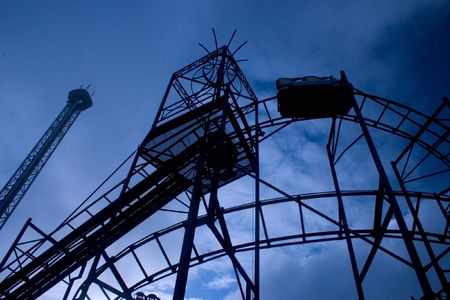Dawn on the Clyde: Glasgows Industrial Awakening
Mist clings to the banks of the River Clyde as dawn gently unfolds over Glasgow, softening the edges of red sandstone and steel. The air is cool and still, yet alive with faint echoes—whispers from a time when this city pulsed to the relentless rhythm of hammers, engines, and sirens. Here, along these storied waters, history lingers in every ripple and reflection. Once, the mighty shipyards lined the river’s edge like proud sentinels, their cranes arching above the skyline, shaping both vessels and destinies. Glasgow was not merely built; it was forged—its very soul interwoven with feats of engineering and invention that would come to define an era. As the sun rises higher, illuminating bridges and docklands, one can almost hear the clangour of rivets and the hum of industry—reminders that this city’s heart still beats in time with its industrial giants.
2. The Bridges that Span Time
Strolling along the banks of the River Clyde, one cannot help but be captivated by the mighty bridges that stride across its ever-flowing waters. These structures are more than mere crossings—they are silent witnesses to Glasgow’s relentless march through history, each bearing tales woven into the city’s industrial fabric. As you approach them, their silhouettes emerge from the mist like sentinels, steadfastly linking neighbourhoods and hearts on either side.
The Bridges: Guardians of Glasgow’s Memory
The Clyde’s bridges each possess a distinct character, shaped by their era and purpose. Some recall the thunder of shipyards and the clang of steel; others invite quiet reflection on evenings when the city glows gold in the late Scottish sun. They stand as bridges in every sense—connecting past to present, east to west, and people to place.
Stories Carried Across Steel and Stone
| Bridge Name | Year Opened | Distinctive Feature | Role in Glasgow Life |
|---|---|---|---|
| Clyde Arc (“Squinty Bridge”) | 2006 | Sweeping modern arch; iconic cityscape symbol | Gateway between Finnieston and Pacific Quay; backdrop for city events |
| Kingston Bridge | 1970 | Massive motorway span; vital artery for commuters | Main thoroughfare carrying M8 traffic; pulse of daily movement |
| George V Bridge | 1928 | Elegant stone arches; historic significance | Link between north and south banks; echoes with footsteps of generations |
| Albert Bridge | 1871 | Casting of iron balustrades; Victorian grandeur | Connects Saltmarket to Gorbals; path for daily rituals and river walks |
| Titan Crane (Clydebank) | 1907 | Towering cantilever crane; shipbuilding heritage icon | A monument to industrial might; now a visitor attraction with sweeping views |
A Living Tapestry Woven in Iron and Imagination
Beneath these arches, stories flow as ceaselessly as the river itself. Couples linger at dusk, sharing quiet hopes; workers hurry homeward under the gaze of lamplight; children peer over railings, dreaming of ships and far-off shores. Each bridge is a gathering point—a memory bank for celebrations, protests, reunions, and farewells. In their presence, we feel both the sweep of history and the pulse of life unfolding anew with every crossing.
![]()
3. Sound and Steel: The Story of the Shipyards
Drift into the old shipyards along the banks of the Clyde, where the clang of hammers and the hiss of molten steel once filled the Glaswegian air with a symphony all its own. Here, amidst rusted cranes and silent slipways, it is easy to imagine the relentless energy that powered Scotland’s industrial heart. These were places alive with sweat and ambition—where generations of craftsmen shaped iron and steel into proud vessels destined to traverse distant oceans. Every rivet driven and plate welded was a testament to both skill and resilience. The legacy of these yards lingers in the salt-tinged breeze, whispering stories of liners that crossed the Atlantic and warships that stood sentinel during times of conflict. As you walk these storied grounds, take a quiet moment to reflect on those who laboured here—their hands roughened by work, their spirits fuelled by pride in a city renowned for engineering excellence. The shipyards are not simply relics; they are living chapters in Glasgow’s ongoing tale, echoing with memories of industry, community, and the indomitable will to shape the world beyond the Clyde.
4. Locomotives, Cranes, and the Pulse of Progress
Step along the Clyde’s edge, and you will hear the echo of pistons and pulleys—the heartbeat of an age where iron and ambition shaped not just Glasgow, but Britain’s future. Here, mighty foundries once glowed through winter mists, forging colossal locomotives that thundered out across continents, each one a tribute to Scottish ingenuity. The shipyards thrummed with life as cranes—gargantuan steel sentinels—hoisted hulls and engines skyward, their silhouettes etched forever against the city’s skyline.
This was more than industry; it was aspiration made tangible. The great engineering feats scattered along the riverside weren’t merely structures—they were dreams in iron and rivet, stories hammered out on anvils by men whose sweat built empires. Glasgow’s foundries and cranes gave rise to some of the world’s most iconic vessels and railways, sending ripples far beyond Scotland’s misty shores.
| Engineering Landmark | Type | Era | Legacy |
|---|---|---|---|
| The Titan Crane | Shipyard Crane | Early 20th Century | Lifting ocean liners; symbol of industrial might |
| Springburn Works | Locomotive Factory | Late 19th – 20th Century | Produced over 25% of world’s locomotives at its peak |
| Clydebank Shipyards | Shipbuilding Complex | 19th – 20th Century | Birthed RMS Queen Mary & other legendary ships |
The landscape itself tells these tales if you pause to listen: the clang of hammers on metal echoes faintly in the breeze, while moss creeps quietly over old rail lines—a gentle reclaiming by nature. Yet even as rust settles, the spirit lingers. Each crane’s arm stretched skywards is a salute to generations who dared to dream bigger, who saw in every girder a promise of progress. Here on the banks of the Clyde, innovation is not just remembered—it is woven into every stone and steel beam beneath your feet.
5. Modern Glasgow: Reimagining Old Giants
The River Clyde, once the relentless heartbeat of Scotland’s industrial might, now hums with a softer, more creative energy. As you walk its banks today, it is impossible not to feel the quiet dialogue between past and present. The colossal warehouses and brick skeletons that once roared with the clang of shipbuilding and heavy industry are now canvases for reinvention, their steel bones softened by the colour and rhythm of modern Glasgow life.
From Shipyards to Studios
Wander down towards Finnieston or the Broomielaw, and you’ll see how these former powerhouses have become sanctuaries for artists and innovators. Old dockside cranes stand as sculptural sentinels, while inside converted warehouses, painters set up easels where riveters once worked. The Hydro’s shimmering curves rise up where once only the silhouettes of cranes dominated the skyline, hosting concerts that send music tumbling out into the night air.
Culture Flourishes Where Industry Ruled
The Clyde’s new pulse beats in cultural gatherings—art fairs nestled in red-bricked spaces, independent cafés buzzing with conversation, and riverside pop-up markets drawing Glaswegians from all walks of life. Murals bloom across faded walls, telling stories of both hardship and hope, while theatres and galleries invite locals and visitors alike to step inside and dream anew. There’s a gentle pride here: a sense that Glasgow hasn’t forgotten her roots but has woven them into something vibrant and enduring.
A Living Tapestry of Old and New
Children cycle along promenades built on old railway lines; couples linger at sunset as riverboats drift past places where steamships were born. Evenings bring street musicians whose melodies echo beneath iron bridges, mingling with laughter from bustling pubs housed in what were once granaries or foundries. It is here, among these repurposed giants, that you truly feel the spirit of Glasgow—a city forever shaped by its industrious past yet endlessly reinventing itself along the ever-flowing Clyde.
6. Walking Into Tomorrow: Reflections by the River
As you stroll along the banks of the Clyde, a soft Scottish breeze carries whispers of shipwrights’ laughter and the clangour of riveters from decades past. The great ironworks may have faded into memory, but their imprint lingers in every bridge’s arch and every warehouse brick. Here, where water meets city, you are not simply walking through Glasgow’s geography—you are traversing its very soul.
Pause for a moment beside the river. Let your gaze follow the slow sweep of the Clyde as it glides under the shadow of engineering giants—the Finnieston Crane standing sentinel, modern bridges stretching across like ribbons of ambition. Each footstep echoes with stories: vessels that once launched to distant continents, engineers who dreamed in steel and stone, communities built on industry and resilience.
Yet this riverside is no museum piece frozen in time. Listen closely: there is a new rhythm pulsing through these streets—a creative energy weaving old with new. Artists sketch murals on ancient walls; cyclists zip past former dockyards now humming with cafés and innovation hubs. Glasgow’s heritage is not just remembered—it is lived, adapted, and celebrated.
The path ahead invites you forward, urging you to discover how yesterday’s sweat and ingenuity have shaped today’s vibrant cityscape. As you wander, let your imagination roam as freely as the river itself, drawing inspiration from both the grandeur of industrial might and the quiet persistence of everyday Glaswegians who call this place home.
So come—walk these riverside ways. Let the stories of steel and stone guide your steps, connecting you to a Glasgow that honours its storied past yet never stops reaching for tomorrow. In every reflection on the Clyde’s surface lies a promise: a city rooted in history, forever forging ahead.


